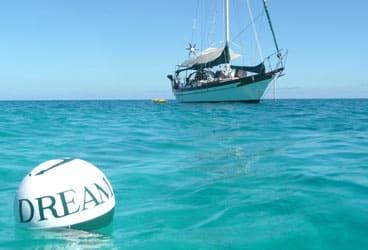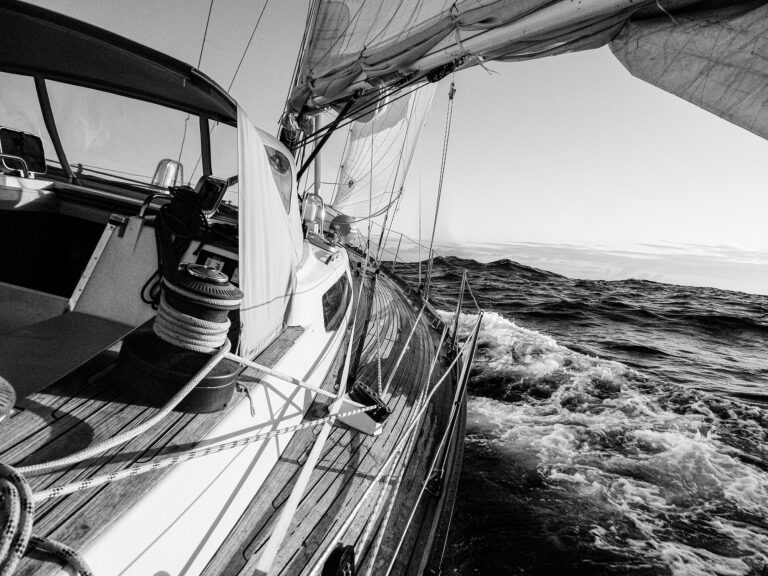
Dream Time
A cold front was fast approaching. With it forecast to deliver strong winds and 20-foot seas to the area, my wife, Catherine, and I had limited options: steer Dream Time, our 1981 Cabo Rico, down one of the evacuation routes that we’d plotted on our charts, navigating us away from the labyrinth of French Polynesian coral atolls and out into open seas, where we’d heave to and weather the storm. Or enter the Arikitamiro Pass into the lagoon at Makemo atoll through an entrance that was blocked by a barricade of breaking seas created by the building and shifting northwesterly wind that signaled the approaching front.
We’d timed the end of our 500-mile passage from Nuku Hiva, in the Marquesas, to arrive at Makemo, our first Tuamotu atoll, in the early morning; we hoped to enter the narrow passage and by lunch be anchored inside the lagoon in front of the village of Pouheva. But when we arrived, the tide had already begun ebbing, and the atoll, a giant 40-mile by 10-mile ring of islands and reef, was already draining back out into the Pacific, causing the ripping eight-knot outgoing current to collide with the heavy incoming swell, resulting in an impressive explosion of whitewater from eight-foot breaking waves. With Island Buoy and Sentinel, two other sailboats that were also trying to enter, we tacked offshore for seven hours while waiting for a slack low tide, the ideal time to run a passage. But by lunchtime, after weathering 30-knot squalls and listening to reports from cruisers already anchored safely inside the atoll, it was clear that the entrance was still chaotic.
At 1330, to get a better perspective, Island Buoy sent one of its crew up the mast and reported that while breakers still covered much of the entrance, the eastern side of the passage, close to the reef’s edge, seemed to offer a slight lull in the surf. The cruisers who’d already entered Makemo’s lagoon heard our radio traffic and offered their assistance; they formed a group on the beach by the pass to provide us with valuable reports of the conditions via handheld VHF radios and, I suspect, to watch the excitement should we decide to enter. They, too, said that the conditions had improved, but only marginally.
With no one wanting to be responsible for claiming that the entrance was now passable, radios fell silent, and our three boats hovered outside, captains and crews processing the information and grappling with the anxiety of the decision. It was now slack tide, and it was clear that the conditions wouldn’t improve. Soon the tide would begin flooding, and with the front almost upon us, the pass would deteriorate even further. A decision had to be made: Turn around and run for open water, or prepare the boat and enter the pass.
After a few stressful minutes, with the lure of a calm anchorage and a good night’s sleep just too appealing to pass up, we shrugged on life jackets, clipped on harnesses, closed up the boat, and reported to Island Buoy and Sentinel that we were going in. With Catherine standing defiantly on the coachroof to look for shallow water, her feet set firmly apart and one hand clutching a stay, the other a halyard, we motored headfirst into the passage and toward the surf.
The sea conditions changed dramatically from the choppy yet manageable swell to a sudden and distinct line of confused breaking waves formed by the strong northwesterly winds driving and funneling the open ocean into the narrow, shallow pass. With white knuckles and a racing heart I motored on, steering Dream Time for the marginally calmer waters along the eastern side of the channel, between the reef and the turbulent breakers blocking the center of the entrance. To maintain control and steerage, we motored ahead at a steady five knots and braced ourselves for the first assault, a seven-foot wave that reared up from the depths, driven to the surface by an undercurrent. We met the wave head-on, riding up the face and falling off its back into a trough that seemed to swallow us whole. There was no turning back.
The water suddenly grew shallow as our keel crossed over into the entrance, the depth rising from 800 feet to 50 in less than a boat length. Spinning the helm and adjusting the throttle, we powered through, over and around the next assault of breaking seas. Surfing at times, our speed would accelerate to 10 knots as we slipped off the back of a wave; then, suddenly, we’d be struggling to make headway, caught in an eddy or a trough. But Dream Time felt solid and reassuring, her bowsprit never wandering more than a few degrees off track, and with Catherine easily able to see the shallow water, we ploughed ahead, carving our way forward through the whitewater.
The ride was exhilarating. Then, as if to offer us a little reassurance, giant dolphins, the biggest we’ve ever seen, escorted us the rest of the way into the atoll. They played off our bow waves and leaped from the water, performing spectacular somersaults over the crests; their enthusiasm was infectious. They seemed to be welcoming us to Makemo, perhaps letting us know that all would be OK and that we should relax and enjoy ourselves. And surprisingly, for the rest of our wild ride in, we did.
Read more about the sailing adventures of Neville and Catherine Hockley at their website (www.zeroXTE.com).








